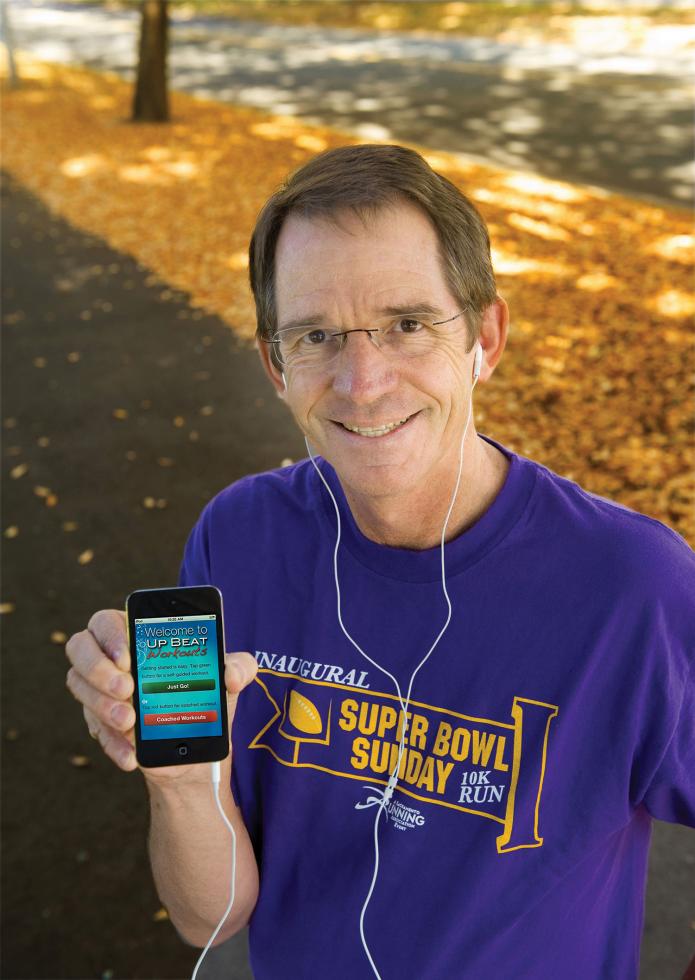Fred Sconberg, Upbeat Workouts Apps

A Sacramento software startup has launched an iPhone application for runners that picks music to go with a workout and can add customized coaching instructions along with the beat. When users pay to download the coaching data, a donation goes to a nonprofit of the coach’s choice.
Farther south in the valley, a Stockton nonprofit that aims to increase activities for disabled people has begun dabbling in a business that arranges disability-friendly outings for clients and their families. The goal: Generate additional revenue to support the nonprofit’s mission.
Across the Capital Region and the world, nonprofits and philanthropists are focusing attention on such “social enterprise” strategies, which often take the form of a business venture that generates cash. The additional revenue can reduce the reliance on charitable donations, grants and government support, cutting the relentless fundraising pressure on a nonprofit and moving it closer to sustainability.
“This has become a really hot topic over the past few years,” says Ann Lucas, executive director of the Nonprofit Research Center in Sacramento. “I think a kind of fever has developed around it as we’ve seen other forms of revenue go away” during the economic downturn.
There can be significant obstacles to launching and sustaining a social enterprise, among them a lack of capital or shortage of expertise about the market or running the venture. Even so, “there are some people who tout it as a silver bullet for everything that’s wrong with nonprofits,” she says.
The hottest topic in nonprofits has a history that goes back centuries. Harvard University was founded in the 1600s and charges for educational services to support its operations. Education and health care (through nonprofit hospitals) have long used the social enterprise model.
It’s also integral to other types of nonprofits, both here and around the world, with examples most of us would instantly recognize:
• Girl Scouts of the USA, founded in 1912, has been using its annual cookie sale to support operations and develop skills in its members since at least 1917.
• Goodwill Industries International Inc., a $3.2 billion nonprofit, dates back to a 1902 venture in Boston that collected used goods and trained the poor to mend them for resale or use by those in need. Founder Rev. Edgar Helms called it an “industrial program as well as a social service enterprise” that provided employment and job training along with assistance.
• Pride Industries of Roseville began when a group of parents met in an Auburn church basement in 1966 to discuss finding work for their children with disabilities. Pride now gets some 99 percent of its more than $150 million in annual revenue from service and product sales across the nation, has more than 2,700 employees with disabilities and calls itself the second-largest manufacturing and service company in the greater Sacramento area.
• A wide array of nonprofits, from the American Red Cross to the local Nonprofit Resource Center, charge fees for training and use the proceeds to support their operations.
So it’s not as if social enterprise is a brand-new approach, but several factors have combined in recent years to push it to the forefront of discussion in the nonprofit world.
As baby boomers approach retirement, their attention has turned toward social causes, in some cases through launching new nonprofits. At the same time, attitude surveys show that young people are more attuned to “doing good and doing well,” says Jerry Hildebrand, executive director of the Global Center for Social Entrepreneurship at University of the Pacific in Stockton. The center is one of 25 focused on the growing field at U.S. universities.
“More students want to create an enterprise that has more than a bottom-line approach,” adds Lewis Gale, Dean of the Eberhardt School of Business at University of the Pacific, which is working in partnership with the social entrepreneurship center.
Other factors also fueled the interest in “do-gooders with spreadsheets,” Hildebrand says. Among them were the global successes of microcredit — using small loans to support business startups that can help lift people out of poverty — and applying modern business tools to measure the results produced by charitable efforts.
Add to those trends the economic downturn, which has depressed charitable giving and increased demand for social services, and social enterprise becomes a more attractive tool in the nonprofit toolkit. “This move is both supply- and demand-driven,” Gale says.
“The recession didn’t cause this, but it accelerated it,” says Charley Ansbach, president of Ansbach & Associates, a consulting and management firm in Sacramento focused on the nonprofit sector. At a time of donor fatigue and fundraising burnout, he says, social enterprise approaches are “a new pony in the corral.”
Many nonprofit executives these days wonder whether that new pony could help them carry their financial burden.
“More students want to create an enterprise that has more than â?¨a bottom-line approach.”>/p>
Lewis Gale, dean, University of the Pacific Eberhardt School of Business
Roger Slingerman heard about social enterprise through the United Way and through University of the Pacific’s center. Slingerman is executive director of the Recreational Sports Club of San Joaquin, which is also known as Opportunities for Persons with Disabilities. It offers its clients about 30 golf, fishing, bocce and other recreational outings per year. While a board and volunteers assist Slingerman, he’s the only staff member, and social enterprise seemed like a way to help make RSC financially sustainable, he says.
“I didn’t know anything about it, but once they started talking about Goodwill and Pride Industries I understood better,” he says.
Slingerman attended a series of workshops for nonprofits offered by the university’s social entrepreneurship center (roughly 70 of the 200 nonprofits in Stockton have taken part in the program). He put together a feasibility study for RSC Adventures, a new venture to offer disability-friendly trips to customers and their families. “It was an extension of what we already did,” he says, and held promise of adding another revenue stream to the registration fees, grants and individual gifts that now support RSC.
The Stockton nonprofit offered a couple of RSC Adventures trips this summer, but while they were well received they didn’t turn a profit, Slingerman says. He still sees promise in the venture, but now has a better idea of what must be done to market it, possibly partnering with existing programs to provide a steady customer base or with a travel agency to promote the specialized trips. He also has a better feel for the additional resources it takes to simultaneously run the nonprofit and launch a social enterprise.
“I believe in what social enterprise can do,” Slingerman says. “It just may take some of us a little longer to get there.”
The place where nonprofit goals meet business acumen is fertile ground for backers of social enterprise. “Traditionally, business is very suspicious of nonprofits, and nonprofits are very suspicious of business,” Hildebrand says. But with nonprofit executives frequently starting fresh each year to develop a budget — with 75 to 80 percent of their time devoted to raising money — a strategic business approach to developing reliable revenue offers the potential of real benefits.
Fred Sconberg accumulated decades of experience — from the 1992 sale of family-owned office products store Lynn Edwards Corp. through a series of businesses including digital photo printing and home health services — before he ventured into the world of social enterprise. When he looked into earning a master’s degree, he found the social entrepreneurship center at University of the Pacific. “It’s always seemed to me that the social model in the United States is based on giving people money,” he says, and the notion that markets and consumer choice could also play a role in social and environmental causes was attractive.
As part of his class work, Sconberg developed a business plan for a campus retail cooperative stocked with coffee, chocolate and other merchandise produced and sourced using a fair trade model. College students would run the store, helping to support themselves as well as farmers and workers who produce the goods.
Now he’s director of business development for Upbeat Workouts Apps, a Sacramento startup that launched an iPhone application in September. Company chief executive Sally Edwards was a founder of the Fleet Feet footwear chain and an accomplished distance runner and triathlete. The company’s first product allows runners to match their music to their pace or select music with a tempo that matches a target pace.
In addition, Sconberg says, users can download custom coaching instructions from within the application, with the 99-cent cost going to a charity selected by the coach. Eventually, the company hopes to work with other nonprofits to offer exercise instructions tailored to their cause, such as workouts for diabetics or stroke patients.
While nonprofits often have board members with significant business experience, they commonly are wary about tapping that expertise except when it comes to fundraising, Ansbach says.
Some would-be donors are bringing their expertise along when they write that check. Social Venture Partners of Sacramento, launched about two years ago, was formed by a group of entrepreneurs and philanthropists who were looking to do more than make a donation, says Raymond Burnell, director of engaged philanthropy for the group. The partners have decided to focus on local education nonprofits — four so far — to build their capacity for sustainability, both through financial contributions and by providing business expertise. The backers sometimes join the board of the nonprofit and work with the group to set benchmarks for progress.
That kind of expert help and targeted capital will be crucial for social enterprise efforts to succeed, Lucas says. “Groups should remember the statistic that 50 percent of all small businesses fail, and ask themselves ‘Do we have the resources and expertise to launch a successful business venture?’ … They need to do their due diligence.”
Not every nonprofit will find success through social enterprise, but it’s another avenue that could work for many, Ansbach says. “It’s not an ‘either/or.’ It’s a ‘this, and,’” he adds. “It’s incumbent on organizations to use, or at least consider, all the tools available.”
Recommended For You

Tech Appeal
Leveraging social media for a nonprofit cause
Monica Gonzalez recently logged onto the Facebook page of Weave Inc., an organization that treats survivors of domestic and sexual abuse, to post a simple message about how the nonprofit helped her overcome a nightmarish ordeal.

United We Stand
Done wisely, nonprofit mergers can boost economic vitality
In the fall of 2011, the executive directors of the Sacramento Philharmonic and the Sacramento Opera sat in their respective offices staring bleakly at financial reports that were telling each of them what they already knew:


